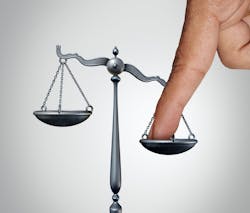Think back to your middle school science class. Picture sitting in a room with your classmates, at a long lab table with a thick black top, staring at a graduated cylinder filled with a mystery concoction created by the teacher before class began. As class time passes, different densities begin to emerge from the emulsion, stratifying into identifiable and distinguishable layers with their own unique attributes, a brown layer, a cloudy milky layer, a red layer, and a clear layer at the top. The lesson teaches about densities and creates awareness based upon observations of the experiment in the graduated cylinder. This is an early lesson in science classes and forms a foundation for greater learning in the future.
The collision industry is really the emulsion residing inside the graduated cylinder. For many years, the industry has appeared homogeneous and consistent. Insurers and information providers viewed and treated repairers as a homogeneous group of equals. Yet, over time, just like the childhood science lesson, the emulsion of the industry began to separate and stratify into identifiable layers with distinguishing attributes. Cycle time, training, tooling, OEM certification, and advanced substrate specialization began to define the layers appearing in the industry. This, however, is when the early science lesson was forgotten and the opportunity for observations and advancement remains.
2020 has been a year for civil movements and the fight for equality and equity in our nation. In the context of the collision industry, treating all shops the same would appear to be a major victory in equality. But that is only half the battle. Treating all shops the same is no longer equitable; it is unfair. Insurers manage severity by comparing shops within a market to one another using a myriad of KPIs. These comparisons are healthy and have been the catalyst to improving cycle time and customer service to new levels. However, due to stratification, all shops are no longer equal, but KPIs assume total equality. This is where the inequality resides. A common KPI, average labor hours, is not equitable between repairers of different stratifications.
Comparing a shop that does not participate in I-CAR Gold Class or other more advanced trainings to a shop that is OEM trained, certified, and audited for procedural compliance is like comparing apples to zucchini. Insurers have every right to manage severity. However, the KPI of average labor hours is blind to diversity. Average labor hours rewards shops for skipping or subletting calibrations and inspections and punishes shops who train and equip to perform these operations in house, saving insurers time and money. The discrimination occurs during performance reviews with insurers when the shop who performs calibrations and inspections in-house is scored lower, put on probation, or has referral capacity reduced as a corrective action for choosing not to sublet work. Another inequitable KPI tracks the number of manual line entries on an estimate. This can also result in unfavorable reviews from insurers for doing the right thing.
All information provider databases are designed to be used as guides only when preparing an estimate. Each repair is possibly unique and dependent upon the repairer’s commitments and business decisions as to how many manual line entries are required to document the complete repair. Again, stratification in the industry matters, but is not acknowledged during insurance performance reviews. Shops that only add manual line entries for basic operations like retaping moldings and freight are not competing within the same stratification as shops who are performing OEM certified levels of repairs. OEM inspections, ADAS calibrations, initializations, and other emerging operations have limited availability in databases. These additional repair considerations are causing friction during performance reviews. Repairers that perform complete repairs are again viewed negatively by being treated as equals.
Equality is not equity. What is right for one, is not right for all. The collision industry is at the early stages of awakening to disparities present in performance reviews from insurers and KPIs provided by the big data aggregators. It is through mindful observation of the stratification occurring in our industry that the greatest lessons can be learned and KPIs, surveys, and other severity control methods can be re-engineered to become more targeted, more equitable, and more effective going forward for the advancement and success of all stakeholders. After all, we are all in this together, but we may or may not be equal.



